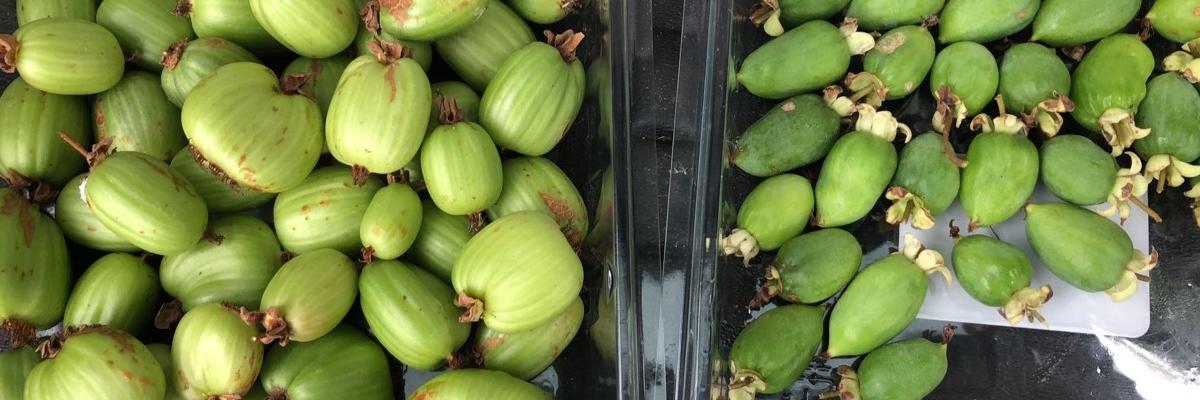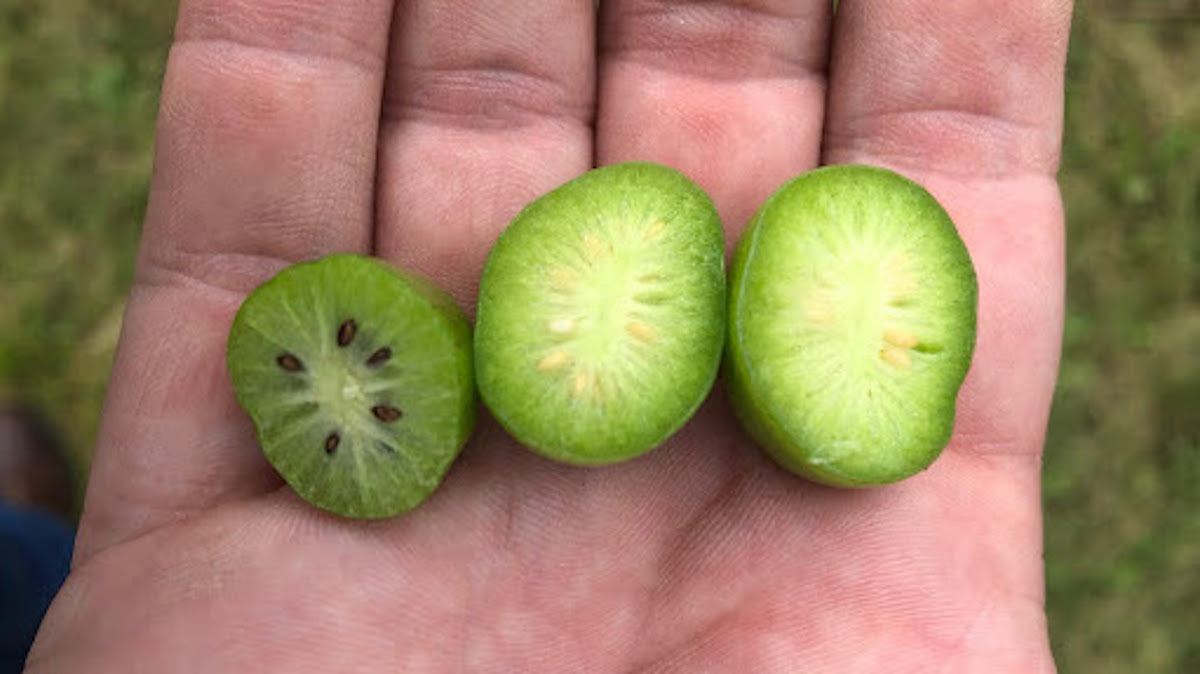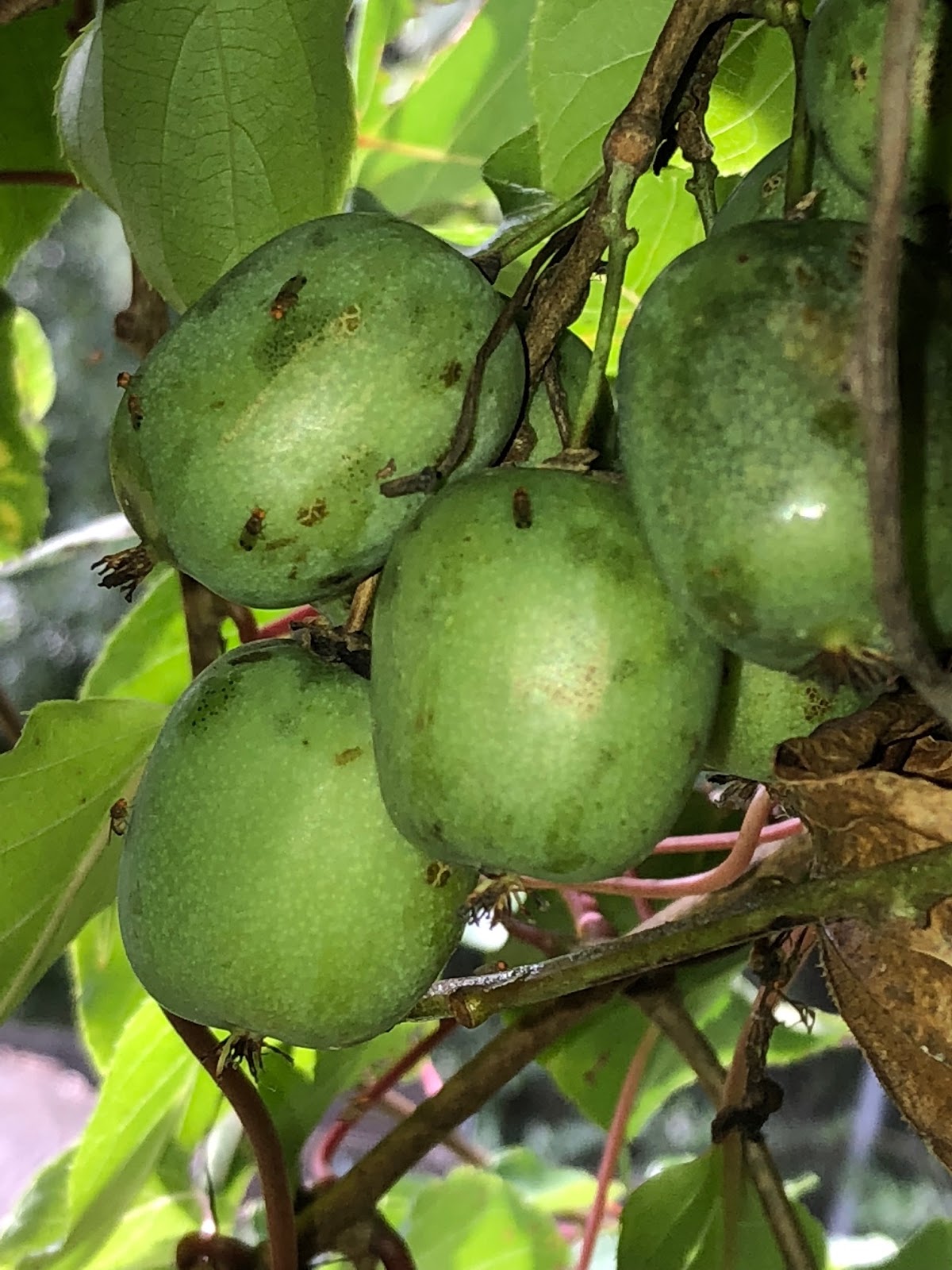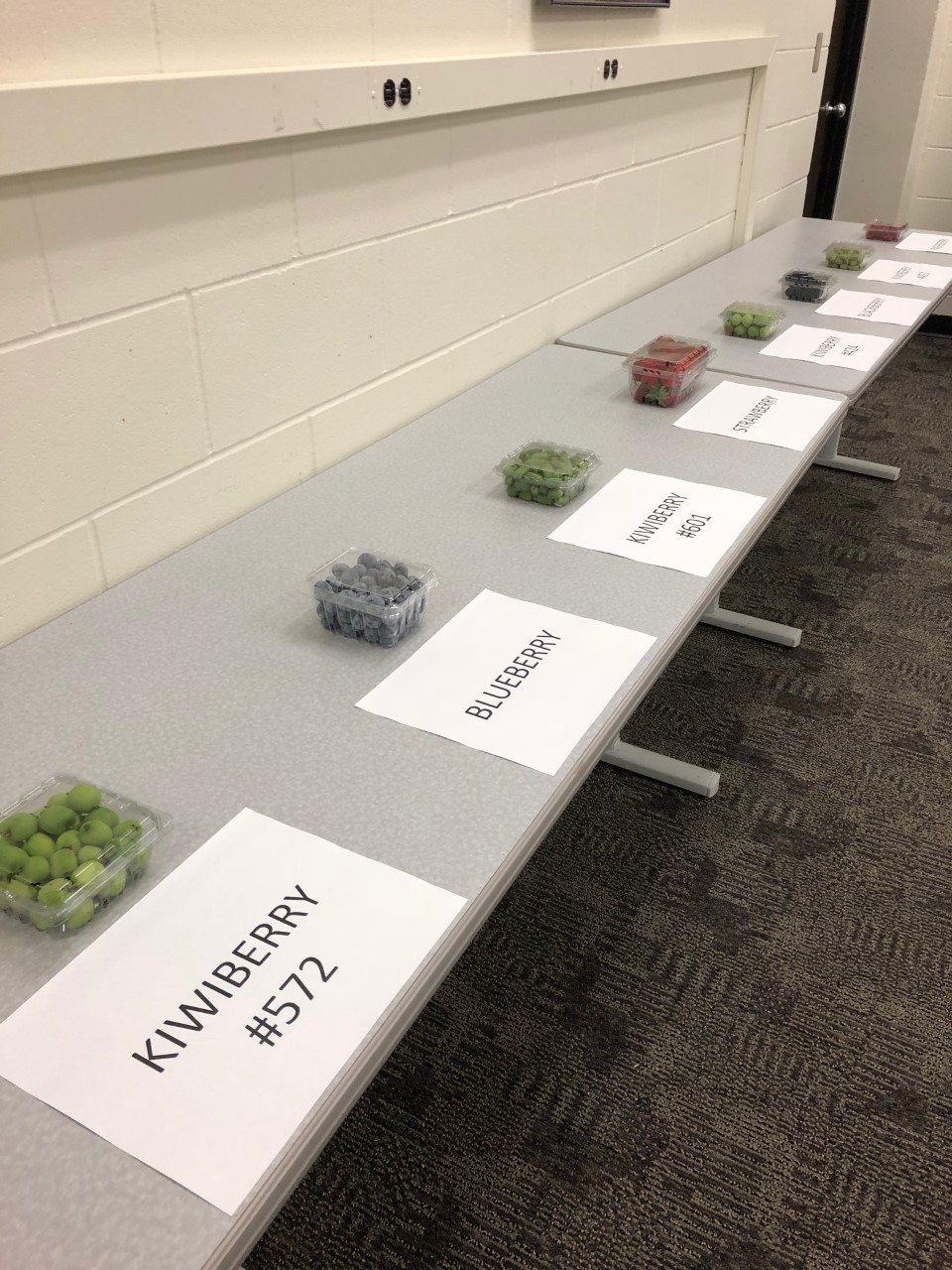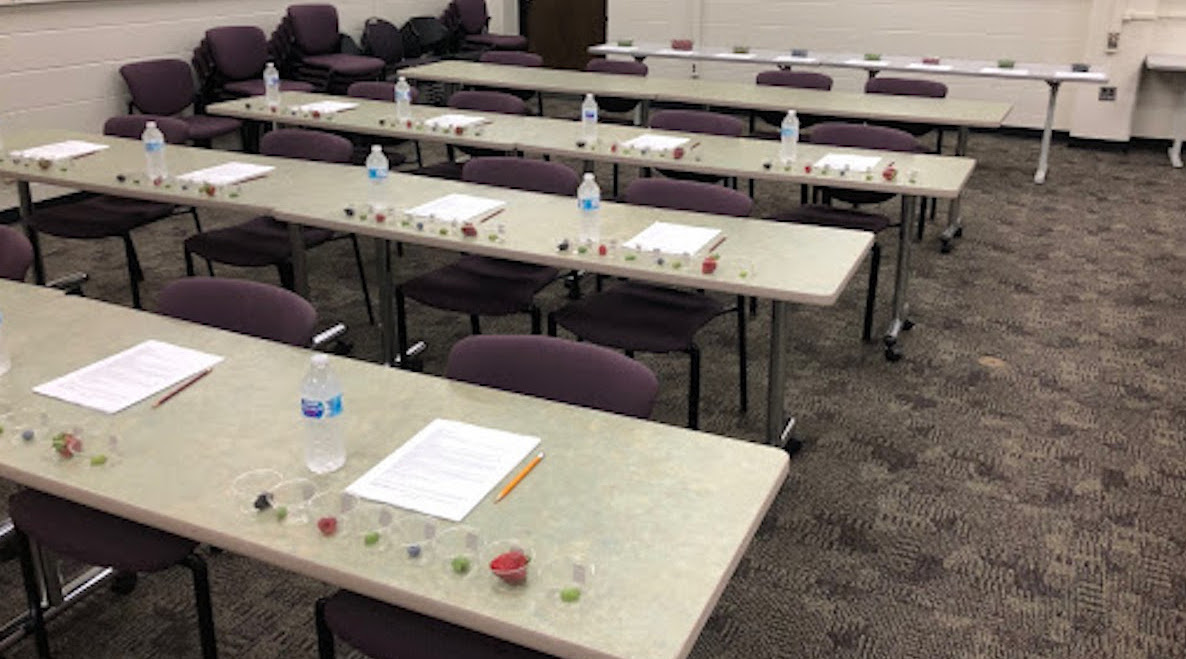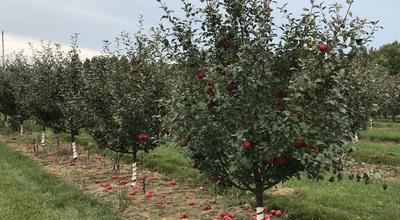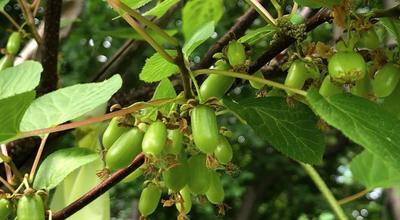Kiwiberries are relatives of kiwifruit (most commonly Actinidia deliciosa), and have the potential to be a new and exciting crop for Minnesota. Two species of kiwiberry - also called hardy kiwi - show promise for growers with cold hardiness (A. kolomikta) and an interesting suite of flavors (A. arguta). However, in order for these exotic tasting fruits to be grown and produced in northern climates, research is needed to identify optimal harvest windows, post-harvest storability, nutritional value, pest pressures, and consumer preferences.
When do the berries ripen?
Determining when fruits are ready to eat and store can be tricky because not all berries in a bunch are ready at the same time. In order to gauge if a kiwiberry vine's fruits are nearing reproductive maturity, cut open a few berries and look at the seed color. If the seeds have changed color from a light brown to black, then the fruit may be ready to harvest and store. This tends to be early August for A. kolomikta and late August or mid-September for A. arguta.
However, seed color alone is not enough to decide to harvest. Seeds may be black, but the fruit may not be developed enough to ripen in storage. This is why researchers at the University of Minnesota have been working to determine the optimal number of growing degree days for harvest. In order to pinpoint this information, fruits are harvested from a plant for multiple weeks over its growing season. These fruits are stored for a number of weeks with samples taken weekly to examine post-harvest qualities such as sugar content, acidity, nutritional components, and firmness. This research will help inform growers and home gardeners about when berries can be harvested and how long these berries retain their quality in storage.
What are the spots on my kiwiberry?
Harvest date and post-harvest analyses are important for harvesting at peak quality, but the fruits have to last unblemished in the field long enough to reach harvest. Luckily, few pests seem to bother kiwiberry. The most important pests affecting kiwiberry include spotted wing drosophila (SWD), sooty blotch and flyspeck. SWD is an invasive pest that can be found on many fruit crops in the region. Sooty blotch and flyspeck are superficial fungi that grow as black blotches or spots, respectively, on the fruit surface that can easily be washed away before eating.1 Some kiwiberry varieties, however, appear to have less fungal infections than others and this may be linked to possible skin tissue differences. This is leading researchers to examine skin structures for differences that might make varieties less susceptible to fungal infection and better-looking fruit.
Can kiwiberry become a commercial crop?
As research continues on harvest, post-harvest storability, nutritional values, and pest pressures, the question remains of whether kiwiberry could be grown and marketed on a commercial scale in Minnesota. As mentioned, A. kolomikta and A. arguta are two prominent species of kiwiberry being researched at the University of Minnesota. A. kolomikta is a cold-hardy kiwiberry capable of withstanding temperatures down to -35°F which shows promise for production in the lower two-thirds of Minnesota.2 A. arguta is less cold-hardy, -20 to -30°F, but has been found to present a wider range of interesting flavors. These exotic flavors and moderate cold hardiness make A. arguta a promising crop for the southern regions of the state.3 With few pest pressures impacting either species combined with their cold hardiness, kiwiberry has a great potential for organic production.
Once producers have kiwiberries, where will they sell them?
In order to gauge consumer acceptance in the Twin Cities, an auction and survey were conducted examining consumer willingness-to-pay for kiwiberries compared to other berry crops (strawberry, blueberry, raspberry, and blackberry). The auction is called a second price auction and is used to more accurately capture what consumers would pay for a product.4 Essentially this auction is a silent auction where participants write down how much they want to pay for an item, in this case fruit in 6oz plastic containers, and then submit them to the monitor. Participants are paid for their participation and informed at the start of the auction that if they win, they will pay their bid and receive the product they won. Once everyone submits a bid, the bids are organized highest to lowest. This is where the second price comes in because the winner does not pay what they bid, but the second highest bid, or second price.
In this auction participants submitted bids for strawberry, blueberry, raspberry, blackberry, two varieties of A. arguta, and two varieties of A. kolomikta. Based on preliminary results, consumers in the Twin Cities appear to be willing to pay the most for strawberries and were willing to pay more for certain kiwiberries than other berries such as blackberries. A. arguta appeared to be the favored kiwiberries with the flavors impressing participants and being described as “tropical.” Though kiwiberries were not the top of these preliminary results, further examination combining demographic data, such as age or income, with auction data will hopefully reveal a target audience for growers.
Future outlook for kiwiberry: research and production
Though the research is ongoing about proper harvest and marketing, the future of kiwiberry in Minnesota looks bright. Consumers in the Twin Cities have shown interest in kiwiberries and are looking to find them in the grocery aisle. Fruit breeders at the University of Minnesota will continue working to develop cold-hardy, flavorful kiwiberry varieties to bring tropical flavors into local production.
More info about kiwiberries
Keep up with our kiwiberry research.
Learn about growing kiwiberries and other fruits in Growing Fruit in the Northern Garden.
Find info on commercial fruit production at University of Minnesota Extension.
Discover how to grow fruit at home from University of Minnesota Extension.
This research is funded by the Minnesota Department of Agriculture and made possible through the University of Minnesota Department of Horticultural Science. Thanks to Bob Guthrie, Dr. James Luby, Dr. Adrian Hegeman, and John Tillman. Thanks also to Dr. Chengyan Yue for her help with the economics study.
References
1. Williamson, S.M. and T.B. Sutton. 2000. Sooty blotch and flyspeck of apple: etiology, biology, and control. Plant Disease, 84(7), pp.714-724.
2. Xiao, Z.A., L.C. Wan and B.W. Han. 2004. An interspecific somatic hybrid between Actinidia chinensis and Actinidia kolomikta and its chilling tolerance. Plant Cell, Tissue and Organ Culture, 79(3), pp.299-306.
3. Boyd, L.M., M.A., McNeilage, E.A. MacRae, A.R., Ferguson, R.A. Beatson, P.J. Martin, and M.H. Williams. 2002. September. Development and commercialization of ‘baby kiwi’(Actinidia arguta Planch.). In V International Symposium on Kiwifruit, 610, pp. 81-86.
4. Yue, C., T.M. Hurley, and N. Anderson. 2011. Do native and invasive labels affect consumer willingness to pay for plants? Evidence from experimental auctions. Agricultural Economics, 42(2), pp.195-205.
Images
All images in this article are by Seth Wannamuehler.
Featured image: Harvested berries from two varieties of A. kolomikta.
Image 1. Kiwiberries sliced open to display differences in seed color between mature and immature seeds.
Image 2. SWD and sooty blotch are the two most common pests of kiwiberries in Minnesota and are shown on a cluster of A. arguta fruit.
Image 3. Fruit on display for participants to examine before bidding during the economic study examining consumer willingness-to-pay for kiwiberries.
Image 4. Room set up for fruit tasting during an economic study examining consumer willingness-to-pay for kiwiberries.
